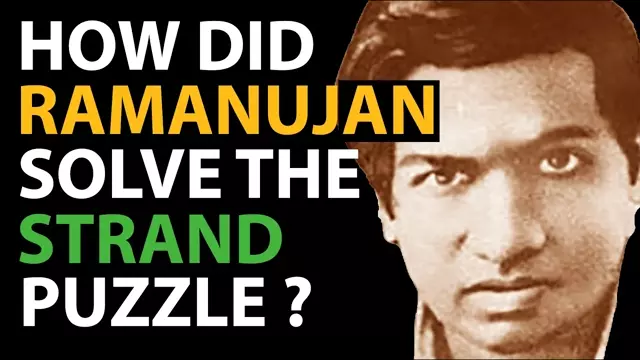2020-09-05
[public] 481K views, 21.7K likes, 233 dislikes audio only
Today's video is about making sense of an infinite fraction that pops up in an anecdote about the mathematical genius Srinivasa Ramanujan.
00:00 Intro
04:31 Chapter 1: Getting a feel for the puzzle
08:27 Chapter 2: Algebra autopilot
12:37 Chapter 3: Infinite fraction
17:51 Chapter 4: Root 2
21:19 Chapter 5: Euclidean algorithm
30:15 Chapter 6: The best of the best: 17/12
36:34 Chapter 7: Outramanujing Ramanujan
This was supposed to be a short video but in the end turned out to be quite a tricky to sort out. Anyway, as it sometimes happens, I got carried away and now the video really covers a lot of ground : Pell equations, visualising continued fractions by dissecting rectangles into squares, the relationship between continued fractions and the Euclidean algorithm, the irrationality of root 2. Overall quite a few things that you won't find anywhere else :)
The way I tell the anecdote in this video is based on the following account by Ramanujan's friend Prasanta Mahalanobis: Current Science, Vol. 9 (3), pp. 74-75.
"On another occasion, I went to his room to have lunch with him. The First World War had started some time ago. I had in my hand a copy of the monthly Strand Magazine which at that time used to publish a number of puzzles to be solved by the readers. Ramanujan was stirring something in a pan over the fire for our lunch. I was sitting near the table, turning over the pages of the Strand Magazine. I got interested in a problem involving a relation between two numbers. I have forgotten the details but I remember the type of the problem. Two British officers had been billeted in Paris in two different houses in a long street; the two numbers of these houses were related in a special way; the problem was to find out the two numbers. It was not at all difficult; I got the solution in a few minutes by trial and error. In a joking way, I told Ramanujan, 'Now here is a problem for you'. He said, 'What problem, tell me', and went on stirring the pan. I read out the question from the Strand Magazine. He promptly answered 'Please take down the solution' and dictated a continued fraction. The first term was the solution which I had obtained. Each successive term represented successive solutions for the same type of relation between two numbers, as the number of houses in the street would increase indefinitely. I was amazed and I asked him how he got the solution in a flash. He said, 'Immediately I heard the problem it was clear that the solution should obviously be a continued fraction; I then thought, which continued fraction? And the answer came to my mind. It was just as simple as this.' "
There is a complete digital archive of The Strand magazine. You can find the page with the puzzle here: https://tinyurl.com/y2lnb8xf (page 790)
If you read the puzzle in the Strand you'll find that the problem is actually phrased somewhat differently to what Mahalanobis remembers and Mahalanobis also does not spell out the infinite fraction that Ramanujan came up with. And if you do the math(s) some of the other things he says also don't quite sound right. What I am presenting in this video is my best guess for what really happened.
In particular, the continued fraction that I am talking about in video is probably the most natural candidate for Ramanujan's infinite fraction, but others have argued that it could have been a different continued fraction (which I don't buy :) You can find these other infinite fractions here: 'Ramanujan's Continued Fraction for a Puzzle" by Poo-Sung Park https://tinyurl.com/yyfdscgr and here 'On Ramanujan, continued fractions and an interesting street number' by John Butcher https://tinyurl.com/yy6nv2yg
Solution to the red cross puzzle from Dudeney's book "Amusements in Mathematics" p. 168 :) https://imgur.com/a/bBuLOZN
Another interesting way to systematically search for solutions to the Strand puzzle is this: The equation we want to solve is 2 x^2=y^2+y. You can rewrite this as x^2 = y(y+1)/2. The formula on the right is just the formula for 1+2+3+...+y. So just keep adding 1+2+3+... and at every step check whether the number you get is a square ... :)
Other short formulas: 1) Expanding (1+√ 2)^n gives a number a+b√2. Then a/b is the nth partial fraction. 2) Play with powers of the matrix {{2, 1}, {1, 0}}
Some number Easter eggs are hiding on this slide /youtube/video/V2BybLCmUzs :)
Link to the unlisted Marching Squares video: https://youtu.be/f1yDExNAEMg
Here is a version of the t-shirt I am wearing: https://tinyurl.com/y5vgo7zb This one is about that other famous Ramanujan anecdote: https://tinyurl.com/y626c86x actually features prominently in another one of my videos.
The music in this video is by Chris Haugen, Fresh Fallen Snow (playing in the video) and Morning Mandolin (for the credits) and Nate Blaze 'Tis the season, all from the free YouTube music library
Enjoy!
Burkard
14.9.2021: Thank you very much Michael Didenko for your Russian subtitles.
/youtube/video/leFep9yt3JY
/youtube/video/yk6wbvNPZW0
/youtube/video/V2BybLCmUzs?t=271
/youtube/video/V2BybLCmUzs?t=507
/youtube/video/V2BybLCmUzs?t=757
/youtube/video/V2BybLCmUzs?t=1071
/youtube/video/V2BybLCmUzs?t=1279
/youtube/video/V2BybLCmUzs?t=1815
/youtube/video/V2BybLCmUzs?t=2194
/youtube/video/XR2u7izwZ04
/youtube/video/94mV7Fmbx88

